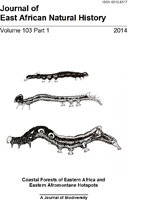Kimberly E. Medley, John K. Maingi
Journal of East African Natural History 103 (1), 1-24, (1 October 2014) https://doi.org/10.2982/028.103.0104
KEYWORDS: Afromontane, Eastern Arc Mountains, montane vegetation, plant diversity, tropical forest ecology
Mount Kasigau, the most northeastern mountain in the Eastern Arc, rises steeply from arid plains to a moist summit at 1641 m. This paper examines the diversity contributions of this afromontane setting by compiling a chorological analysis of tree species richness, measuring ecological differences among forest community types, and interpreting physical-environmental and human-historical factors that influence diversity patterns. Between 2002 and 2006, stem densities and basal areas of woody plants > 10 cm dbh were measured in 55 (0.1 ha) plots placed at different elevations. The study reports 140 species, 46 were measured in only one plot, and affinities for 75 species to the Somalia-Masai (43%), Afromontane (29%), and Zanzibar-Inhambane (Coastal, 28%) floristic regions. Cluster and Indicator Species Analyses identified eight community types. Mount Kasigau uniquely conserves much forest cover and a diversity of woody plant species below evergreen forest at 1000 m. Ordination, using Nonmetric Multidimensional Scaling (NMDS), resulted in a three-dimensional solution that explained 47.9% of the variation among plots. Axis 2 showed the strongest relationship with elevation (R2= 0.523), but lower montane community types also vary by slope form, slope aspect, and past human activities. We show how this biogeographical analysis of diversity patterns at Mount Kasigau can guide local management and support important opportunities for montane forest conservation in East Africa.

